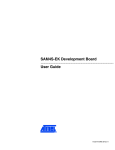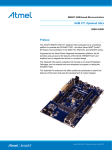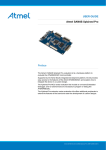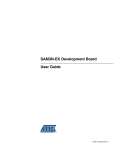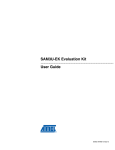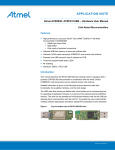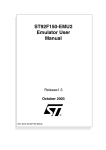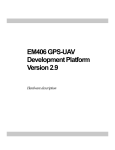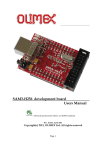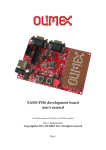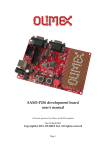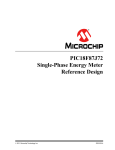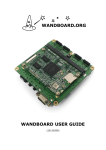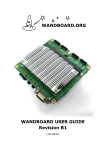Download SAM4E-EK User Guide
Transcript
SAM4E-EK User Guide SAM4E-EK Evaluation Kit 42067B−SAM4E−04/2013 Table of Contents 1. Introduction .......................................................................................... 3 1.1 Scope ….. .......................................................................................................... 3 1.2 User guide ......................................................................................................... 3 1.3 References and applicable documents ............................................................. 3 2. Kit Contents ......................................................................................... 4 2.1 Deliverables ...................................................................................................... 4 2.2 Electrostatic warning ......................................................................................... 5 3. Power Up ............................................................................................. 6 3.1 Power up the board ........................................................................................... 6 3.2 Source code and technical support ................................................................... 6 4. Board Description ................................................................................ 7 4.1 Board overview ................................................................................................. 7 4.2 Features list ...................................................................................................... 8 4.3 Function blocks ................................................................................................. 9 4.3.1 Processor............................................................................................ 9 4.3.2 Memory …. ......................................................................................... 9 4.3.3 Clock circuitry ................................................................................... 10 4.3.4 Reset circuitry ................................................................................... 10 4.3.5 Power supply and management ....................................................... 11 4.3.6 UART ….. ......................................................................................... 12 4.3.7 USART ….......................................................................................... 12 4.3.8 RS485 …… ...................................................................................... 13 4.3.9 Ethernet MAC 10/100 (EMAC).......................................................... 13 4.3.10 CAN …….......................................................................................... 14 4.3.11 Display interface ............................................................................... 14 4.3.11.1 LCD module .................................................................... 14 4.3.11.2 Backlight control.............................................................. 15 4.3.12 Touch screen interface ..................................................................... 16 4.3.13 JTAG/ICE.......................................................................................... 16 4.3.14 Audio Interface .................................................................................. 17 4.3.15 USB device ....................................................................................... 17 4.3.16 Analog interface ................................................................................ 18 4.3.16.1 Analog reference............................................................. 18 4.3.16.2 Analog input .................................................................... 18 4.3.16.3 Analog output .................................................................. 19 4.3.17 QTouch elements ............................................................................. 20 4.3.18 LEDs …….......................................................................................... 20 4.3.19 SD/MMC card ................................................................................... 21 4.3.20 ZigBee ……. ..................................................................................... 21 4.3.21 PIO expansion .................................................................................. 21 5. Configuration ...................................................................................... 23 5.1 PIO usage ....................................................................................................... 23 5.2 Jumpers .......................................................................................................... 26 6. Schematics ........................................................................................ 27 7. Revision History ................................................................................. 36 SAM4E-EK User Guide 42067B−SAM4E−04/2013 2 1. Introduction 1.1 Scope This user guide introduces the SAM4E-EK Evaluation Kit (SAM4E-EK) and describes its development and debugging capabilities. Figure 1-1. Atmel SAM4E-EK board. 1.2 User guide This guide gives details on how the Atmel® SAM4E-EK has been designed. It is made up of six chapters: • • • • • • 1.3 Chapter 1 includes references, applicable documents, acronyms and abbreviations Chapter 2 describes the kit contents, its main features Chapter 3 provides instructions to power up the SAM4E-EK and describes how to use it Chapter 4 describes the hardware resources including default jumper and switch settings and the schematics Chapter 5 provides all the board schematics Chapter 6 provides troubleshooting instructions References and applicable documents Table 1-1. References and applicable documents. Reference Title Comment Lit. no.: 11157 SAM4E datasheet www.atmel.com SAM4E-EK User Guide 42067B−SAM4E−04/2013 3 2. Kit Contents 2.1 Deliverables The Atmel SAM4E-EK toolkit contains the following items: • • • • • • • An Atmel SAM4E-EK board Power supply Universal input AC/DC power supply with US, Europe and UK plug adapters One USB cable One serial RS232 cable One Ethernet cross cable A welcome letter Figure 2-1. Unpacked SAM4E-EK. Unpack and inspect the kit carefully. Contact your local Atmel distributor if you have issues concerning the contents of the kit. SAM4E-EK User Guide 42067B−SAM4E−04/2013 4 2.2 Electrostatic warning The Atmel SAM4E-EK board is shipped in a protective anti-static bag. The board must not be subjected to high electrostatic potentials. A grounding strap or similar protective device should be worn when handling the board. Avoid touching the components or any other metallic element of the board. SAM4E-EK User Guide 42067B−SAM4E−04/2013 5 3. Power Up 3.1 Power up the board Unpack the board taking care to avoid electrostatic discharge. Unpack the power supply, select the right power plug adapter corresponding to that of your country, and insert it into the power supply. Connect the power supply DC connector to the board and plug the power supply to an AC power socket. The board LCD should light up and display a welcome page. Then click or touch the icons displayed on the screen and enjoy the demo. 3.2 Source code and technical support After boot up, you can run some sample code or your own application on the development kit. You can download sample code and get technical support from the Atmel web site: http://www.atmel.com. SAM4E-EK User Guide 42067B−SAM4E−04/2013 6 4. Board Description 4.1 Board overview This chapter introduces the Atmel SAM4E-EK Evaluation Kit design. It introduces system-level concepts, such as power distribution, memory, and interface assignments. The SAM4E-EK board is based on the integration of an ARM® Cortex™-M4 processor with on-board NAND Flash and a set of popular peripherals. It is designed to provide a high performance processor evaluation solution with high flexibility for various kinds of applications. Figure 4-1. SAM4E-EK block diagram. SAM4E-EK User Guide 42067B−SAM4E−04/2013 7 4.2 Features list The list of the main board components and interfaces: • • • • • • • • • • • • • • • • • • • • • • • • • SAM4E16 chip BGA144 package with optional socket footprint 12MHz crystal 32.768kHz crystal Optional SMB connector for external system clock input NAND Flash 2.8 inch TFT color LCD display with touch panel and backlight UART port with RS232 driver USART port with RS232 driver multiplexed with RS485 function with driver CAN port with driver Mono/stereo headphone jack output One Ethernet physical transceiver layer with RJ45 connector SD/MMC interface Reset button: NRST User buttons: WAKU, TAMP, Scroll-up, Scroll-down QTouch® buttons: Left, Right and Slider Full Speed USB device port JTAG/ICE port On-board power regulation Three user LEDs Power LED BNC connector for ADC input BNC connector for DAC output User potentiometer connected to the ADC input ZigBee® connector PIO connection interfaces (PIOA, PIOC and PIOD with 32-bit, PIOB with 16-bit, PIOE with 6-bit) SAM4E-EK User Guide 42067B−SAM4E−04/2013 8 4.3 Function blocks 4.3.1 Processor The Atmel SAM4E-EK is equipped with a SAM4E16 device in BGA144 package. 4.3.2 Memory The SAM4E16 chip embeds: • • • 1024kB of embedded Flash 128kB of embedded SRAM 16kB of ROM with embedded boot loader routines (UART, USB) and In-Application Programming functions (IAP) routines The SAM4E16 features an External Bus Interface (EBI) that permits interfacing to a broad range of external memories and virtually to any parallel peripheral. The SAM4E-EK board is equipped with one NAND Flash MT29F2G08ABAEA on the EBI. This can change to other type of flash by setting the Static Memory Controller. Figure 4-2. NAND-Flash. +3V3 R125 47K +3V3 NAND FLASH R126 47K 16 17 8 18 PC17 PC16 PC9 PC10 J37-2 9 PC14 PC18 R131 +3V3 R132 7 19 0R 47K R133 DNP 1 2 3 4 5 6 10 11 14 15 20 21 22 23 24 25 26 MN10 MT29F2G08ABAEA CLE ALE RE WE CE R/B WP N.C1 N.C2 N.C3 N.C4 N.C5 N.C6 N.C7 N.C8 N.C9 N.C10 N.C11 N.C12 N.C13 N.C14 N.C15 N.C16 N.C17 I/O0 I/O1 I/O2 I/O3 I/O4 I/O5 I/O6 I/O7 N.C28 N.C27 N.C26 N.C25 N.C24 N.C23 PRE N.C22 N.C21 N.C20 N.C19 N.C18 VCC VCC VSS VSS 29 30 31 32 41 42 43 44 PC0 PC1 PC2 PC3 PC4 PC5 PC6 PC7 48 47 46 45 40 39 38 35 34 33 28 27 +3V3 37 12 36 13 C93 100nF C92 100nF C94 1uF NCS0 chip select signal is used for NAND Flash chip selection. Furthermore, a dedicated jumper can disconnect it from the on-board memories, thereby letting NCS0 free for other custom purposes. SAM4E-EK User Guide 42067B−SAM4E−04/2013 9 4.3.3 Clock circuitry The clock generator of a SAM4E16 microcontroller is composed of: • • • A low-power 32.768Hz Slow Clock Oscillator with bypass mode • • A 80 to 240MHz PLL (PLLB) providing a clock for the USB Full Speed Controller A 3 to 20MHz Crystal Oscillator, which can be bypassed (12MHz needed in case of USB) A factory programmed fast internal RC Oscillator. Three output frequencies can be selected: 4 (default value), 8 or 12MHz An 80 to 240MHz programmable PLL (PLLA), capable to provide the clock MCK to the processor and to the peripherals. The input frequency of PLLA is from 3 to 32MHz The SAM4E-EK board is equipped with one 12MHz crystal, optional Piezoelectric Ceramic Resonator 12MHz (Murata ref. CSTCE12M0G15L99-R0), one 32.768Hz crystal and an external clock input connector. Figure 4-3. External clock source. C22 18pF R3 Y1 C27 0R PA7 32.768 kHz 18pF R4 0R PA8 J2 SMB 2 4 1 3 5 R5 DNP R6 49.9R 1% R7 DNP 15pF R8 0R PB9 0R PB8 3 4 Y2 2 C31 R12 4.3.4 2 3 1 1 C28 15pF Y3 12MHz R11 DNP Reset circuitry On-board NRST button BP1 provides an external reset control of the SAM4E16. The NRST pin is bidirectional. It is handled by the on-chip reset controller. It can be driven low to provide a reset signal out to the external components. Conversely, it can be asserted low from the outside to reset the microcontroller Core and the peripherals. The NRST pin integrates a permanent pull-up resistor of 100kΩ to VDDIO. On the SAM4E-EK board, the NRST signal is connected to the LCD module and JTAG port. Note: At power-on, the NRST signal is asserted with default duration of two clock cycles. That duration may not be sufficient to correctly reset any other system or board devices connected to that signal. First, in your custom application, you need to check for these device’s datasheets about reset duration requirements. Then, you need to set an appropriate configuration in the NRST Manager. This is done through the ERSTL field in the RSTC_MR register. The NRST duration is thereby configurable between 60μs and 2s, whether it is subsequently activated by a software reset or a user reset. Refer to the SAM4E16 datasheet for in-depth information. SAM4E-EK User Guide 42067B−SAM4E−04/2013 10 Power supply and management The Atmel SAM4E-EK board is supplied with an external 5V DC block through input J1. It is protected by a PolyZen diode (MN2) and an LC combinatory filter (MN3). The PolyZen is used in the event of an incorrect power supply connection. The adjustable LDO regulator MN4 is used for the 3.3V rail main supply. It powers all the 3.3V components on the board. Figure 4-4. Power block. J1 MN2 Power Jack 2.1mm ZEN056V130A24LS 1 1 3 2 1 MN3 BNX002-01 2 C23 100nF 2 3 + C24 22uF SV CV SG CG1 CG2 CG3 +5V 3 4 5 6 + C25 22uF + C26 220uF-ELE-16V MN4 MIC29302 SD VOUT GND2 1 VIN GND1 2 ADJ +3V3 4 5 R9 169K 1% + C29 C30 100uF-TAN-6.3V 100nF 6 +5V 3 4.3.5 R10 102K 1% The SAM4E16 product has different types of power supply pins: • VDDIN pin: Power for the internal voltage regulator, ADC, DAC, and analog comparator power supplies. The voltage ranges from 1.6V to 3.6V. • VDDIO pins: Power for the Peripherals I/O lines. The voltage ranges from 1.62V to 3.6V. • VDDOUT pin: Output of the internal voltage regulator. • VDDCORE pins: Power for the core, including the processor, embedded memories, and peripherals. The voltage ranges from 1.08V to 1.32V. • VDDPLL pin: Power for the PLL A, PLL B and 12MHz oscillator. The voltage ranges from 1.08V to 1.32V. Note: VDDPLL should be decoupled and filtered from VDDCORE. SAM4E-EK User Guide 42067B−SAM4E−04/2013 11 4.3.6 UART The Universal Asynchronous Receiver Transmitter features a two-pin UART that can be used for communication and trace purposes. It offers an ideal channel for in-situ programming solutions. This UART is associated with two PDC channels to reduce the processor time on packet handling. This two-pin UART (TXD and RXD only) is buffered through an RS232 Transceiver MN6 and brought to the DB9 male connector J7. Figure 4-5. UART. DBGU MN7 ADM3202 16 C54 100nF +3V3 +3V3 R58 100K PA10 PA9 6 C56 100nF R59 100K R60 0R R62 0R TP4 15 11 12 10 9 C1+ V+ C1- V- C2+ GND 1 4 J7 1 6 2 7 3 8 4 9 5 C57 100nF 5 C2- T1IN R1OUT T2IN R2OUT C53 100nF 3 14 13 7 8 T1OUT R1IN T2OUT R2IN TP5 10 UTXD0 URXD0 2 C55 100nF VCC 11 +3V3 FGND USART The Universal Synchronous/Asynchronous Receiver Transmitter (USART) provides one full duplex universal synchronous/asynchronous serial link. The data frame format is extensively configurable (data length, parity, number of stop bits) to support a broad range of serial communication standards. The USART is also associated with PDC channels for TX/RX data access. To avoid any electrical conflict, the RS232 and RS485 transceiver are isolated from the receiving line PA21. • • Chose RS485 channel: Close 1-2 pins on JP11 and set PA23 to high level Chose RS232 channel: Close 2-3 pins on JP11 and set PA23 to low level Figure 4-6. USART. USART1 C45 100nF C44 100nF 1 21 C48 100nF R38 47K +3V3 TXD1 RXD1 RTS1 CTS1 23 19 PA23 R37 0R 5 PA22 PA21_232 PA24 PA25 R39 R40 R41 R42 R43 0R 0R 0R 0R 47K 7 10 8 11 9 12 +3V3 VCC C1+ V+ C1C2+ V- GND C2C3+ 6 C46 100nF 20 2 C47 100nF 4 24 J5 EN T1IN R1OUT T2IN R2OUT T3IN R3OUT C3T1OUT R1IN T2OUT R2IN T3OUT R3IN 22 18 15 17 14 16 13 1 6 2 7 3 8 4 9 5 C49 100nF SD R44 0R PA21_485 FGND JP11 2 PA21 PA21_232 11 C43 4.7uF MN5 ADM3312EARU 10 3 1 +3V3 3 4.3.7 SAM4E-EK User Guide 42067B−SAM4E−04/2013 12 4.3.8 RS485 As noticed above the USART1 is shared with the RS485 port, connected to the transceiver MN6 and output to the 3point connector J6. The design includes selectable jumpers for RS485 bus termination resistors selection (JP10, JP12, and JP13). Figure 4-7. RS485. +3V3 +3V3 RS 485 R46 10K RXD1 PA21_485 CTS1 RTS1 TXD1 1 R47 0R PA25 R48 0R 2 PA24 R49 0R 3 PA22 R50 0R 4 R45 DNP MN6 ADM3485ARZ RO VCC RE GND JP10 +3V3 8 C52 100nF 5 1 DE J6 2 DI 6 7 A B 3 R51 120R JP12 JP13 FGND DNP R52 Ethernet MAC 10/100 (EMAC) The EMAC module implements a 10/100 Ethernet MAC compatible with the IEEE® 802.3 standard using an address checker, statistics and control registers, receive and transmit blocks, and a DMA interface. The Atmel SAM4E-EK is equipped with a MICREL KSZ8051MNL 10/100 Mbps Fast Ethernet Physical Layer transceiver. It contains the entire physical layer functions of 100BASE-TX as defined by IEEE 802.3u. The Ethernet interface provides MII for 100Base-TX or 10Base-TX. The MII interfaces are capable of both 10Mb/s and 100Mb/s data rates as described in the IEEE 802.3u standard. The Ethernet interface integrates an RJ45 connector with an embedded transformer, and two status LEDs. Figure 4-8. Ethernet block. GND_ETH PD[0..31] PD14 PD0 PD1 PD16 PD15 PD3 PD2 PD12 PD11 PD6 PD5 PD7 PD4 PD10 PD13 E1_RXCK E1_TXCK E1_TXEN E1_TX3 E1_TX2 E1_TX1 E1_TX0 E1_RX3 E1_RX2 E1_RX1 E1_RX0 E1_RXER E1_RXDV E1_CRS E1_COL R84 R85 R86 R87 R88 R89 R90 R91 R92 R93 R94 R96 R98 R99 R100 19 22 23 27 26 25 24 13 14 15 16 20 18 29 28 RXC TXC TXEN TXD3 TXD2 TXD1 TXD0 RXD3 RXD2 RXD1 RXD0 RXER RXDV CRS COL 22R 22R 22R 22R 22R 22R 22R 22R 22R 22R 22R 22R 22R 22R 22R C76 100nF MN9 RXC/B-CAST_OFF TXC TXEN TXD3 TXD2 TXD1 TXD0 RXD3/PHY AD0 RXD2/PHY AD1 RXD1/PHY AD2 RXD0/DUPLEX RXER/ISO RXDV/CONFIG2 CRS/CONFIG1 COL/CONFIG0 TXP +3V3 22R 22R 22R +3V3 8 7 6 5 E1_MDC R103 E1_MDIO R104 INT_ETH1 R105 8 7 6 5 PD8 PD9 PD28 4.7K 4.7K L5 220ohm at 100MHz 1 2 RR4 4.7k 12 11 21 E1_AVDDT 3 C81 10uF 1 2 3 4 RR3 4.7k R101 R102 +3V3 C82 TXM RXP RXM GND PADDLE MDC MDIO INTRP/NAND 6 TXM 2 TD- TX- 2 RXP 3 RD+ RX+ 3 4 RXM RX- 6 VDDIO 2 1 33 C77 2.2uF C79 100nF C78 100nF 10 LED0/NWAY EN LED1/SPEED 32 7 NC 8 R106 R110 6.49K 470R 8 ETH1_XO 9 ETH1_XI R107 4.7K R108 4.7K 1nF 470R 4 5 75 R109 7 8 FGND 9 10 12 11 30 31 RESET FGND RJ45 ETHERNET CONNECTOR 4 2 R112 ETH1_XI 22pF 1 C85 0R 3 At the De-Assertion of Reset: PHY ADD[2:0]:001 CONFIG[2:0]:000,Mode:MII Duplex Mode:Half Duplex Isolate Mode:Disable Speed Mode:100Mbps Nw ay Auto-Negotiation:Enable 0R 75 +3V3 GND_ETH ETH PHY FGND 75 75 100nF NRST R111 5 CT 6 RD- VDDA_3V3 XI 1 5 +3V3 REXT TX+ 4 CT 13 14 C83 10uF VDD_1V2 XO C84 J20 J00-0061 1 TD+ TXP CT_RX 100nF 17 7 CT_TX KSZ8051MNL 1 2 3 4 4.3.9 Y4 25MHz GND_ETH C86 22pF ETH1_XO SAM4E-EK User Guide 42067B−SAM4E−04/2013 13 4.3.10 CAN The CAN controller provides all the features required to implement the serial communication protocol CAN defined by Robert Bosch GmbH, the CAN specification as referred to by ISO/11898A (2.0 Part A and 2.0 Part B) for high speeds and ISO/11519-2 for low speeds. The CAN Controller is able to handle all types of frames (Data, Remote, Error and Overload) and achieves a bit rate of 1Mbit/sec. The Atmel SAM4E has two CAN Controller with eight Mailboxes. SAM4E-EK connects the CAN0 and CAN1 bus to the CAN transceiver SN65HVD234 (MN11 and MN12). The extension connector (J13 and J14) type is RJ12 female socket. Figure 4-9. CAN block. +3V3 R134 10K PE0 PB2 PE1 PB3 (CANTX0RS) R135 J37-6 (CANTX0) (CANRX0EN) R138 (CANRX0) 0R R139 J13 MN11 8 Rs 1 D 0R 5 EN 0R 4 R R140 10K 1 2 GND JP28 CANH 7 2 3 CANL 6 R137 120R 4 5 6 +3V3 1 2 CAN RJ12 3 4 5 6 VCC 3 SN65HVD234 + C95 10uF C96 100nF CAN0 +3V3 R141 10K PE2 PC15 PE3 PC12 J14 (CANTX1RS) R142 0R MN12 8 Rs (CANTX1) 0R 1 D R143 (CANRX1EN) R149 (CANRX1) R150 0R 5 EN 0R 4 R R151 10K 2 GND SN65HVD234 1 JP29 CANH 7 2 3 CANL 6 R148 120R 4 5 6 +3V3 1 2 CAN RJ12 3 4 5 6 VCC 3 + C98 10uF C99 100nF CAN1 4.3.11 Display interface The SAM4E-EK carries a TFT transmissive LCD module with touch panel, FTM280C34D. Its integrated driver IC is ILI9325. The LCD display area is 2.8 inches diagonally measured, with a native resolution of 240 x 320 dots. 4.3.11.1 LCD module The LCD module gets reset from the NRST signal. As explained, this NRST is shared with the JTAG port and the pushbutton BP1. The LCD chip select signal is connected to NCS1; the jumper JP8 can disconnect it so that this PIO line is available for other custom usage. The SAM4E16 communicates with the LCD through PIOC where an 8-bit parallel “8080-like” protocol data bus has to be implemented in software. SAM4E-EK User Guide 42067B−SAM4E−04/2013 14 Figure 4-10. LCD block. +3V3 PD[0..31] 4.7k DNP 8 RR1 7 DNP 6 4.7k 5 8 RR2 7 DNP 6 4.7k 5 4.7k DNP PA[0..31] C32 PC[0..31] 10uF R14 LCD_DB0 1 2 3 4 1 2 3 4 LCD_DB4 LCD_DB2 LCD_DB3 LCD_DB1 LCD_DB8 LCD_DB6 LCD_DB7 LCD_DB5 R15 LCD_DB9 C33 100nF PC7 PC6 PC5 PC4 PC3 PC2 PC1 PC0 R13 47K LCD_DB17 LCD_DB16 LCD_DB15 LCD_DB14 LCD_DB13 LCD_DB12 LCD_DB11 LCD_DB10 LCD_DB9 LCD_DB8 LCD_DB7 LCD_DB6 LCD_DB5 LCD_DB4 LCD_DB3 LCD_DB2 LCD_DB1 LCD_DB0 +3V3 PC11 PC8 PC19 R16 10K C34 100nF PD18 JP8 NRST NRST LED_A R18 0R The part is placed as close as possible to J4 LED_K1 LED_K2 LED_K3 LED_K4 Y _UP Y _DOWN X_RIGHT X_LEFT 3 4 5 1 R17 4.7K 1 2 3 4 5 6 7 8 9 10 11 12 13 14 15 16 17 18 19 20 21 22 23 24 25 26 27 28 29 30 31 32 33 34 35 36 37 38 39 J3 FH26-39S-0.3SHW Z7 VDD DB17 DB16 DB15 DB14 DB13 DB12 DB11 DB10 DB9 DB8 DB7 DB6 DB5 DB4 DB3 DB2 DB1 DB0 VDD RD WR RS CS RESET IM0 IM1 GND LED-A LEDK1 LEDK2 LEDK3 LEDK4 Y+ YX+ XNC GND PIN 39 PINs on BOT FTM280C34D PIN 1 Six slots on PCB for LCD shield D1 2 NOT POPULATED LCD DNP TVS, SOT23-5 4.3.11.2 Backlight control The LCD backlight is made of four integrated white chip-LEDs arranged in parallel. These are driven by an AAT3155 charge pump, MN15. The AAT3155 is controlled by PC13; the 0Ω resistor R24 is mounted in series on this line, which permits to use it for other custom purposes. In that case, the pull-up resistor R20 maintains the charge pump permanently enabled by default. On the anode drive line, a 0Ω resistor R18 is implemented in series for an optional current limitation. Figure 4-11. Backlight control. +3V3 PC13 R24 0R R20 47K 10 C35 1uF +3V3 FB1 9 11 5 BN03K314S300R C38 4.7uF 4 MN15 AAT3155ITP-T1 C1+ C1EN/SET IN GND C2+ C2OUTCP D1 D2 D3 D4 7 6 C36 1uF TP1 8 LED_A 3 2 1 12 LED_K1 LED_K2 LED_K3 LED_K4 C37 1uF LCD BACKLIGHT SAM4E-EK User Guide 42067B−SAM4E−04/2013 15 4.3.12 Touch screen interface The LCD module integrates a 4-wire touch panel controlled by MN16 (ADS7843) which is a slave device on the SAM4E16 SPI bus. The controller sends back the measurement information about the X and Y positions as a pressure is applied to the touch panel. The touch panel can be used with either a stylus or a finger. The ADS7843 touch panel controller connects to the SPI interface via the NPCS0 control signal. Two interrupt signals are connected and provide events information back to the microcontroller: PenIrq and Busy. PenIrq (PA16) is shared with ZigBee signal ZIGB_MISC. Busy (PA17) is shared with ZigBee signal ZIGB_IRQ. Therefore, if using a ZigBee interface in concurrence with the Touch Screen controller, take care not to have both drivers enabled at the same time on either PA16 or PA17. Note: Figure 4-12. Touch panel control. +3V3 2 3 4 5 X_RIGHT Y _UP X_LEFT Y _DOWN TP2 XP YP XM YM DCLK DIN DOUT CS BUSY PENIRQ TP3 7 8 R27 100K R19 100K MN16 ADS7843E IN3 IN4 VREF VCC1 VCC2 R28 100K AGND_TP GND 16 14 12 15 PA14 PA13 PA12 +3V3 JP9 PA11 13 11 R22 0R 9 1 10 R25 0R R21 100K PA17 R23 0R +3V3 L2 C39 100nF 6 LCD TOUCH SCREEN C40 100nF PA16 C41 100nF 10uH-150mA R26 1R C42 4.7uF R29 0R AGND_TP 4.3.13 JTAG/ICE A standard 20-pin JTAG/ICE connector is implemented on the Atmel SAM4E-EK for the connection of a compatible ARM JTAG emulator interface, such as the SAM-ICE™ from Segger. Note that the NRST signal is connected to BP1 system button and is also used to reset the LCD module. The 0Ω resistor R61 may be removed in order to isolate the JTAG port from this system reset signal. Figure 4-13. JTAG interface. ICE INTERFACE +3V3 R53 100K R54 100K R55 100K R56 100K R57 100K PB4 PB6 PB7 PB5 NRST R61 0R 1 3 5 7 9 11 13 15 17 19 J8 HE10 20PTS VTref Vsupply nTRST GND1 TDI GND2 TMS GND3 TCK GND4 RTCK GND5 TDO GND6 nSRST GND7 DBGRQ GND8 DBGACK GND9 2 4 6 8 10 12 14 16 18 20 SAM4E-EK User Guide 42067B−SAM4E−04/2013 16 4.3.14 Audio Interface The Atmel SAM4E-EK evaluation kit supports mono/stereo audio driven by a TPA0223 audio amplifier connected to two DAC channels of the microcontroller. The TPA0223 is a 2W mono Bridge-Tied-Load (BTL) amplifier designed to drive speakers with as low as 4Ω impedance. The amplifier can be reconfigured on the fly to drive two stereo Single-Ended (SE) signals into head phones. Figure 4-14. Headphone output. 1 2 AUDIO OUT +5V JP14 3 PB13 + C60 10uF C59 1uF C63 AGND 0.47uF DAC0 JP15 TP6 Test Pad SQ-40TH C64 JP16 0.47uF C58 C61 100nF 1K R64 5 LO/MO- 33K R66 47K 0.47uF R67 33K R71 47K SHUTD0WN 33K BY PASS 1 9 10 RIN AGND C62 J10 5 Phonejack Stereo 3.5 4 3 2 1 220uF-TAN-6.3V R63 R65 R72 6 RO/MO+ + VDD 1K 220uF-TAN-6.3V AGND MONO-IN 7 ST/MN LIN 2 4 R68 100K R70 100K C65 VDD_AMP 100K C66 1uF JP17 AGND R73 R69 0.47uF 8 GND 11 PAD AUDIO_OUTL C67 3 + 1 2 +3V3 MN8 TPA0223DGQ FB2 BN03K314S300R VDD_AMP J9 AGND AGND 0R AGND 3 AGND JP18 PB14 1 2 Using a readily available 1/8-in. (3.5mm) stereo headphone jack, the control switch (pin4 and pin5 in J10) is closed when no plug is inserted. When closed, a 100kΩ/1kΩ divider pulls the ST/MN input low. When a jack plug is inserted, the 1kΩ resistor is disconnected and the ST/MN input is pulled high. The mono speaker (J9 connector) is also physically disconnected from the RO/MO+ output so that no sound is heard from the speaker while the headphones are inserted. When works as stereo mode make sure JP15, JP16, and JP17 are disconnected. 4.3.15 USB device The SAM4E16 UDP port is compliant with the Universal Serial Bus (USB) rev 2.0 Full Speed device specification. J11 is a micro B-type receptacle for USB device. Both 27Ω resistors R82 and R83 build up 90Ω differential impedance together with the (embedded) 6Ω output impedance of the SAM4E16 full speed channel drivers. R80 and R81 build up a divider bridge from VBUS +5V to implement plug-in detection (5V level gets lowered to a PIO compatible 3.3V level) through PC21. SAM4E-EK User Guide 42067B−SAM4E−04/2013 17 Figure 4-15. USB. USB PC21 R80 47K R81 68K D+ ID G 11 7 6 5 D- 4 RV1 V5.5MLA0603 USB Micro B 3 1 FGND 5V 2 J11 TBD 10 8 9 RV2 V5.5MLA0603 C75 10pF FGND PB10 R82 27R PB11 R83 27R 4.3.16 Analog interface 4.3.16.1 Analog reference The 3.0V voltage reference is based on a LM4040 (Precision Micropower Shunt Voltage Reference). This ADVREF level can be set as 3.0V or 3.3V via the jumper JP3. Figure 4-16. Analog Vref. +5V 1 +3V3 JP3 2 C13 C14 100nF 1uF R1 2.2K 3 ADVREF MN1 LM4040AIM3X-3.0 4.3.16.2 Analog input • The BNC connector CN2 is connected to the AEF0_AD4 or AFE1_AD0 (selected by JP40) as a single external analog input • The BNC connectors CN3, CN4 are connected to AFE0_AD10 and AFE0_AD11 as a differential external analog input. A low pass filter is optional by close 1-2 pins of JP21, JP22, JP24, and JP25 • Each BNC input has an on-board 50Ω resistor termination that can be applied by closing jumper JP20, JP23 or JP26 • A 10kΩ potentiometer (VR1) is also connected to the AFE0_AD5 implement an easy access to ADC programming and debugging (or implement an analog user control like display brightness, volume, etc.) SAM4E-EK User Guide 42067B−SAM4E−04/2013 18 Figure 4-17. ADC/AFE input. ADC / AFE +3V3 3 Potentiometer Clockwise 2-->3 VR1 10K VR 2 (AFE0_AD5) PB1 PB0 (AFE0_AD4) PB2 (AFE1_AD0, need open JP41) 1 1 C68 10nF CN2 2 BNC JP40 3 JP20 C70 10nF CN3 JP21 JP22 2 C72 R77 49.9R 1 CN4 600R 220uH JP25 2 3 JP26 R78 680pF PC31 (AFE0_AD11) 3 JP24 2 BNC C74 4.7nF DNP C73 680pF L4 (AFE0_AD10) 1 JP23 L3 220uH 1 C71 4.7nF DNP PC30 2 1 BNC 3 3 R76 49.9R R79 49.9R 4.3.16.3 Analog output The BNC connector CN1 is connected to the DAC port PB14 and provides an external analog output. An on-board 50Ω resistor termination can be enabled by closing jumper JP21. A filter can be implemented on this output channel by replacing R74 and C69 with appropriate resistor and capacitor values, depending on the application requirements. 3 Figure 4-18. DAC output. JP18 PB14 R74 0R JP19 C69 2 1 CN1 BNC DAC1 2.2uF R75 49.9R SAM4E-EK User Guide 42067B−SAM4E−04/2013 19 4.3.17 QTouch elements QTouch keys consist in a series of sensors formed by the association of a copper area and the capacitive effect of human fingers approaching it. Keys The Atmel SAM4E-EK implements two individual capacitive touch keys (RIGHT, LEFT). Slider A group of channels forms a Slider. A Slider is composed of eight channels for a QTouch acquisition method. Such a sensor is used to detect a linear finger displacement on a sensitive area. A typical implementation is volume control. Figure 4-19. QT_Slider. S1 MN17 10K 25 RST +3V3 PAD GPIO1 GPIO2 GPIO3 R124 R122 R123 2.2K 2.2K 23 24 7 21 22 I2C_A0 I2C_A1 Y 0A Y 0B VREF VSS VSS 1K 1K 1K 1K 1K 1K 1K K1 29 28 1 2 SMP X6 X5 X4 K2 X3 X2 QKEY QKEY SDA SCL CHANGE Y 1A Y 1B 8 4 18 R114 R115 R116 R118 R119 R120 R121 2 10K PA3 PA4 PE4 6 5 15 14 13 12 11 10 1 1uF 100nF100nFR117 X7 X6 X5 X4 X3 X2 X1 X0 26 19 R127 1K R128 1K X1 X0 2 C88 C87 C89 VDD VDD VDD 1 3 16 17 Slider +3V3 FB3 BN03K314S300R Y0 27 20 R129 R130 9 1M C90 4.7nF C91 4.7nF Qtouch 1M AT42QT2160 4.3.18 LEDs There are three LEDs on the SAM4E-EK board: • • A blue LED (D2), amber LED (D3) and a green LED (D4), which are user defined and controlled by the GPIO A red LED (D5), which is a power LED indicating that the 3.3V power rail is active. It is also controlled by the GPIO and can be treated as a user LED as well. The only difference with the two others is that it is controlled through a MOS transistor. By default, the PIO line is disabled; a pull-up resistor controls the MOS to light the LED when the power is ON Figure 4-20. LEDs. LEDS +3V3 TIMER PA0 R154 470R PWM PD20 R157 470R D3 LED Amber PWM PD21 R158 470R D4 LED Green POWER PD22 D2 LED Blue R159 100K 1 2 3 R160 470R D5 LED Red IRLML2502Q1 SAM4E-EK User Guide 42067B−SAM4E−04/2013 20 4.3.19 SD/MMC card The Atmel SAM4E-EK has a high-speed 4-bit multimedia MMC interface, which is connected to a 4-bit SD/MMC micro card slot featuring a card detection switch. Figure 4-21. SD card. +3V3 VDD_MCI 4 3 2 1 2 SD POWER CTRL R161 0R DNP 1 R30 10K PD23 R31 10K 3 Q2 IRLML6402 J4 TF01A 5 6 7 8 VDD_MCI SD CARD RA1 68Kx4 R162 4.7k PA26 PA27 PA28 R33 R32 0R 0R PA29 R34 0R PA30 PA31 R35 R36 0R 0R 1 2 3 4 5 6 7 8 10 9 PA6 + C50 10uF DAT2 DAT3 CMD VCC CLK VSS DAT0 DAT1 Sh1 Sh2 Sh3 11 12 13 GND CD C51 100nF 4.3.20 ZigBee The SAM4E-EK has a 10-pin male connector for the RZ600 ZigBee module. Note: 0Ω resistors have been implemented in series with the PIO lines that are used elsewhere in the design, thereby enabling their individual disconnection, should a conflict occur in your application. Figure 4-22. ZigBee interface. ZB_RSTN IRQ_ZBEE SPIO_NPCS3# MISO PA18 R152 PA17 R155 PA5 PA12 0R 0R 1 3 5 7 9 J19 HE10 5x2 2 4 6 8 10 R153 R156 0R 0R C100 18pF PA16 PA15 PA13 PA14 C101 2.2nF MISC_ZBEE SLP_TR MOSI JP36 SPCK +3V3 C102 2.2uF ZIGBEE 4.3.21 PIO expansion The SAM4E-EK product features three PIO controllers, PIOA, PIOB, PIOC and PIOD, which are multiplexed with the I/O lines of the embedded peripherals. Each PIO Controller controls up to 32 lines (15 for PIOB and 6 for PIOE). Expansion ports J15, J16, J17 and J18 provide PIO lines access for customer usage. SAM4E-EK User Guide 42067B−SAM4E−04/2013 21 Figure 4-23. PIO expansion. PE[0..5] PB[0..14] PA[0..31] PC[0..31] PD[0..31] PD0 PD1 PD2 PD3 PD4 PD5 PD6 PD7 PD8 PD9 PD10 PD11 PD12 PD13 PD14 PD15 +3V3 1 3 5 7 9 11 13 15 17 19 21 23 25 27 29 31 33 35 37 39 J15 PIO D 2 4 6 8 10 12 14 16 18 20 22 24 26 28 30 32 34 36 38 40 1 PD16 PD17 PD18 PD19 PD20 PD21 PD22 PD23 PD24 PD25 PD26 PD27 PD28 PD29 PD30 PD31 PC0 PC1 PC2 PC3 PC4 PC5 PC6 PC7 PC8 PC9 PC10 PC11 PC12 PC13 PC14 PC15 +3V3 +3V3 +3V3 1 3 5 7 9 11 13 15 17 19 21 23 25 27 29 31 33 35 37 39 J16 2 4 6 8 10 12 14 16 18 20 22 24 26 28 30 32 34 36 38 40 PIO C JP33 +5V 3 1 PC16 PC17 PC18 PC19 PC20 PC21 PC22 PC23 PC24 PC25 PC26 PC27 PC28 PC29 PC30 PC31 PA0 PA1 PA2 PA3 PA4 PA5 PA6 PA9 PA10 PA11 PA12 PA13 PA14 PA15 +3V3 +3V3 +3V3 1 3 5 7 9 11 13 15 17 19 21 23 25 27 29 31 33 35 37 39 J17 2 4 6 8 10 12 14 16 18 20 22 24 26 28 30 32 34 36 38 40 PIO A JP34 +5V 3 1 PA16 PA17 PA18 PA19 PA20 PA21 PA22 PA23 PA24 PA25 PA26 PA27 PA28 PA29 PA30 PA31 PB0 PB1 PB2 PB3 PB4 PB5 PB6 PB7 PB12 PB13 PB14 +3V3 +3V3 +3V3 2 JP32 +5V 3 2 +3V3 2 1 2 JP31 +5V 1 3 5 7 9 11 13 15 17 19 21 23 25 27 29 31 33 35 37 39 3 J18 2 4 6 8 10 12 14 16 18 20 22 24 26 28 30 32 34 36 38 40 PE0 PE1 PE2 PE3 PE4 PE5 +3V3 PIO B & PIO E SAM4E-EK User Guide 42067B−SAM4E−04/2013 22 5. Configuration This chapter describes the PIO usage, the jumpers, the test points and the solder drops of an Atmel SAM4E-EK board. 5.1 PIO usage Table 5-1. PIO Port A pin assignments and signal descriptions. IO line Peripheral A Peripheral B Peripheral C Extra function PA0 PA1 PA2 PA3 PA4 PA5 PA6 PA7 PA8 PA9 PA10 PA11 PA12 PWMH0 PWMH1 PWMH2 TWD0 TWCK0 TIOA0 TIOB0 A17 A18 DATRG WKUP0 WKUP1 WKUP2 URXD0 UTXD0 NPCS0 MISO NPCS3 TCLK0 NPCS3 PCK0 PWMH3 AFE0_ADTRG NPCS1 NPCS2 PWMH0 PWMH1 PA13 MOSI PWMH2 PA14 SPCK PWMH3 URXD1 UTXD1 PWMFI0 WKUP3 WKUP4 WKUP5 WKUP6 WKUP7 WKUP8 PA15 PA16 TIOA1 TIOB1 PWML3 PWML2 WKUP14/PIODCEN1 WKUP15/PIODCEN2 PA17 PA18 PA19 PA20 PA21 PA22 PA23 PA24 PA25 PA26 PA27 PA28 PA29 PA30 PA31 PCK1 PCK2 PWML0 PWML1 PCK1 NPCS3 PWMH0 PWMH1 PWMH2 TIOA2 TIOB2 TCLK1 TCLK2 NPCS2 PCK2 PWMH3 A14 A15 A16 AFE0_AD0 AFE0_AD1 AFE0_AD2/WKUP9 AFE0_AD3/WKUP10 AFE1_AD2 AFE1_AD3 PIODCCLK PIODC0 PIODC1 PIODC2 PIODC3 PIODC4 PIODC5 WKUP11/PIODC6 PIODC7 RXD1 TXD1 SCK1 RTS1 CTS1 DCD1 DTR1 DSR1 RI1 PWML2 NPCS1 NCS2 A19 A20 A23 MCDA2 MCDA3 MCCDA MCCK MCDA0 MCDA1 SYSIO and GPIO XIN32 XOUT32 Comments LED_TIMER (Blue) BUTTON_SCROLL-UP BUTTON_SCROLL-DOWN QTouch_SDA QTouch_SCL ZIGB_SEL#, SPI FLASH_CS# SD_CD XIN32 XOUT32 DBGU_ROUT DBGU_TIN TOUCH_CS# TOUCH_DOUT, ZIGB_MISO, SPI FLASH_SO TOUCH_DIN, ZIGB_MOSI, SPI FLASH_SI TOUCH_DCLK, ZIGB_SCLK, SPI FLASH_SCK ZIGB_SLP_TR TOUCH_PENIRQ#, ZIGB_MISC TOUCH_BUZY, ZIGB_IRQ ZIGB_RST# BUTTON_WAKU BUTTON_TAMP RS232_RXD, RS485_RXD RS232_TXD, RS485_TXD RS232_EN# RS232_RTS, RS485_DE RS232_CTS, RS485_RE# SD_DAT2 SD_DAT3 SD_CMD SD_CLK SD_DAT0 SD_DAT1 SAM4E-EK User Guide 42067B−SAM4E−04/2013 23 Table 5-2. PIO Port B pin assignments and signal descriptions. IO line Peripheral A PB0 PB1 PB2 PB3 PB4 PB5 PB6 PB7 PB8 PB9 PB10 PB11 PB12 PB13 PB14 PWMH0 PWMH1 CANTX0 CANRX0 TWD1 TWCK1 NCPS2 PCK2 PWMH2 PWML0 PWML1 PWML2 NPCS1 PCK0 PWMH3 Table 5-3. Peripheral B Peripheral C Extra function SYSIO and GPIO RXD0 TXD0 CTS0 RTS0 AFE0_AD4/RTCOUT0 AFE0_AD5/RTCOUT1 AFE1_AD0/WKUP12 AFE1_AD1 TDI TDO/TRACESWO TMS/SWDIO TCK/SWCLK XOUT XIN DDP DDM ERASE WKUP13 SCK0 DAC0 DAC1 Comments AFE0_BNC ADC_Potentiometer CAN0_D, AFE1_BNC CAN0_R JTAG_TDI JTAG_TDO JTAG_TMS JTAG_TCK XOUT XIN USB_D+ USB_DERASE AUDIO_RIN AUDIO_LIN, DAC1_BNC PIO Port C pin assignments and signal descriptions. IO line Peripheral A Peripheral B PC0 PC1 PC2 PC3 PC4 PC5 PC6 PC7 PC8 PC9 PC10 PC11 PC12 PC13 PC14 PC15 PC16 PC17 PC18 PC19 PC20 PC21 PC22 PC23 PC24 PC25 PC26 PC27 D0 D1 D2 D3 D4 D5 D6 D7 NWE NANDOE NANDWE NRD NCS3 NWAIT NCS0 NCS1 A21/NANDALE A22/NANDCLE A0 A1 A2 A3 A4 A5 A6 A7 A8 A9 PWML0 PWML1 PWML2 PWML3 NPCS1 TIOA6 TIOB6 TCLK6 TIOA7 TIOB7 TCLK7 TIOA8 TIOB8 PWML0 TCLK8 PWML1 PWMH0 PWMH1 PWMH2 PWMH3 PWML3 TIOA3 TIOB3 TCLK3 TIOA4 TIOB4 Peripheral C Peripheral D Extra function AFE0_AD14 AFE1_AD4 AFE1_AD5 AFE1_AD6 AFE1_AD7 CANRX1 AFE0_AD8 AFE0_AD6 CANTX1 AFE0_AD7 SYSIO and GPIO Comments NAND_D0/LCD_DB10 NAND_D1/LCD_DB11 NAND_D2/LCD_DB12 NAND_D3/LCD_DB13 NAND_D4/LCD_DB14 NAND_D5/LCD_DB15 NAND_D6/LCD_DB16 NAND_D7/LCD_DB17 LCD_WR NAND_OE# NAND_WE# LCD_RD CAN1_R LCDBL_EN/SET NAND_CE# CAN1_D NAND_ALE NAND_CLE NAND_R/B# LCD_RS USB_VBUS AFE0_AD12 AFE0_AD13 SAM4E-EK User Guide 42067B−SAM4E−04/2013 24 PC28 PC29 PC30 PC31 Table 5-4. A10 A11 A12 A13 Peripheral A PD0 PD1 PD2 PD3 PD4 PD5 PD6 PD7 PD8 PD9 PD10 PD11 PD12 PD13 PD14 PD15 PD16 PD17 PD18 PD19 PD20 PD21 PD22 PD23 PD24 PD25 PD26 PD27 PD28 PD29 PD30 PD31 GTXCK/GREFCK GTXEN GTX0 GTX1 GCRSDV/GRXDV GRX0 GRX1 GRXER GMDC GMDIO GCRS GRX2 GRX3 GCOL GRXCK GTX2 GTX3 GTXER NCS1 NCS3 PWMH0 PWMH1 PWMH2 PWMH3 PWML0 PWML1 PWML2 PWML3 IO line PE0 PE1 PE2 PE3 PE4 AFE0_AD9 AFE0_AD10 AFE0_AD11 AFE0_BNC AFE0_BNC PIO Port D pin assignments and signal descriptions. IO line Table 5-5. TCLK4 TIOA5 TIOB5 TCLK5 Peripheral B Peripheral C Peripheral D Extra function SYSIO and GPIO Comments MII_TXCK MII_TXEN MII_TX0 MII_TX1 MII_RXDV MII_RX0 MII_RX1 MII_RXER ETH_MDC ETH_MDIO MII_CRS MII_RX2 MII_RX3 MII_COL MII_RXCK MII_TX2 MII_TX3 LCD_CS LED_PWM (Amber) LED_PWM (Green) LED_PWR (RED) SD_PWR_CTL ETH_INTR PIO Port E pin assignments and signal descriptions. Peripheral A Peripheral B Peripheral C Peripheral D Extra function SYSIO and GPIO Comments CAN0_Rs CAN0_EN CAN1_Rs CAN1_EN QTouch_CHANGE# SAM4E-EK User Guide 42067B−SAM4E−04/2013 25 5.2 Jumpers The Atmel SAM4E-EK board jumpers are essentially used for two main purposes: functional selection or current measurement. Details are given below. Table 5-6. 2 pin jumpers setting. Name Signal Close Open J37-1 J37-2 J37-3 J37-4 J37-5 J37-6 JP7 JP9 JP8 J39-1 J39-2 J39-3 J39-4 JP15 JP16 JP17 JP19, JP20, JP23 SPI FLASH_CS (NPCS3) NAND_CE# (NCS0) VDDCORE VDDIO VDDIN CANTX0 ERASE TOUCH_CS# (NPCS0) LCD_CS (NCS1) BUTTON_SCROLL-UP BUTTON_SCROLL-DOWN BUTTON_TAMP BUTTON_WAKU PB13(DAC) to MONO-IN (Audio) PB14(DAC) to MONO-IN (Audio) Audio_ST/MN# BNC input 50Ω match resister Connect (default) Connect (default) Connect (default) Connect (default) Connect (default) CANTX0 can use Erase internal flash Connect (default) Connect (default) Connect (default) Connect (default) Connect (default) Connect (default) Connect (default) Connect (default) Force mono mode Use Disconnect Disconnect Disconnect Disconnect Disconnect AFE1_AD0 can use Default Disconnect Disconnect Disconnect Disconnect Disconnect Disconnect Disconnect (default) Disconnect (default) No force (default) No use (default) Name Signal 1-2 close 2-3 close JP11 JP3 JP14 JP18 JP31, JP32, JP33, JP34 JP21, JP22, JP24, JP25 JP40 PA21 ADVREF Audio power DAC_PB14 PIOA/B/C/D-CONN-power AFE0_AD10/AD11 ADC BNC input RS485-RX 3.3V (default) 5V (default) To CN1 (BNC) 5V Use filter(default) To AFE0_AD4 RS232-RX 3.0V 3.3V To Audio_LIN (default) 3.3V Bypass filter To AFE1_AD0 SAM4E-EK User Guide 42067B−SAM4E−04/2013 26 6. Schematics This chapter contains the following schematics: • • • • • • • • Block diagram Microcontroller TFT-LCD and touch COM and SD card and JTAG Audio and USB Ethernet QTouch, CAN and Flash memories I/O Peripheral SAM4E-EK User Guide 42067B−SAM4E−04/2013 27 A B C 5 5 V Input POWER SUPPLY (3.3V) Sheet 6 ETHERNET(100M) Sheet 3 BACK LIGHT 2.8" 240x320 TFT LCD INTERFACE TOUCH SCREEN Sheet 5 ADC(AFE)/ DAC AUDIO Out (DAC) FS USB (Divce) Sheet 2 PHONE JACK BNC POT 4 POWER 4 PIO A, B, C 3 Sheet 2 ATMEL Cortex-M4 ARM Processor SAM4E (BGA144) 3 PIO A, B, C 2 2 QTOUCH Sheet 8 PIO A, B, C Extension LEDs, Buttons ZIGBEE INTERFACE Sheet 4 ICE(JTAG) USART1 DBGU HSMCI Sheet 7 CAN0 / 1 SPI FLASH NAND FLASH RJ12 HE 10 RS232 / 485 Micro SD HE 10 A 1/1 INIT EDIT MODIF. SCALE REV 1 XX DES. DATE 1 1 8 REV. A DATE SHEET VER. 23-OCT-12 XXX XX-XXX-XX This agreement is our property. Reproduction and publication without our written authorization shall expose offender to legal proceedings. TOP SAM4E-EK HE 14 D 5 A B C D Figure 6-1. Block diagram. SAM4E-EK User Guide 42067B−SAM4E−04/2013 28 A B C D AT91SAM4E-BGA144 AT91SAM4E-BGA144 AT91SAM4E-BGA144 PIOD U1B PIOC 5 PD0 PD1 PD2 PD3 PD4 PD5 PD6 PD7 PD8 PD9 PD10 PD11 PD12 PD13 PD14 PD15 PD16 PD17 PD18 PD19 PD20 PD21 PD22 PD23 PD24 PD25 PD26 PD27 PD28 PD29 PD30 PD31 PC0 PC1 PC2 PC3 PC4 PC5 PC6 PC7 PC8 PC9 PC10 PC11 PC12 PC13 PC14 PC15 PC16 PC17 PC18 PC19 PC20 PC21 PC22 PC23 PC24 PC25 PC26 PC27 PC28 PC29 PC30 PC31 U1D D4 B5 A5 B7 D6 D7 A8 B8 E9 D9 C12 E11 G10 G9 H10 A11 K11 L11 M10 M9 K9 H9 M8 M7 M6 M5 L6 J6 K10 D10 M1 D3 E4 J4 K4 L3 J5 L8 K7 M4 J12 G11 F10 F11 F4 G2 E10 G1 D11 B12 B10 D8 A9 A7 C7 C6 B6 C5 F2 E2 L12 F3 F1 E1 C11 D12 E12 F12 K12 M11 B9 L2 M2 M12 L9 J9 L10 M3 K6 L5 K5 J1 H2 H1 H3 K2 K3 L4 L7 K8 J8 J10 C9 A6 A10 C8 PD0 PD1 PD2 PD3 PD4 PD5 PD6 PD7 PD8 PD9 PD10 PD11 PD12 PD13 PD14 PD15 PD16 PD17 PD18 PD19 PD20 PD21 PD22 PD23 PD24 PD25 PD26 PD27 PD28 PD29 PD30 PD31 PC0 PC1 PC2 PC3 PC4 PC5 PC6 PC7 PC8 PC9 PC10 PC11 PC12 PC13 PC14 PC15 PC16 PC17 PC18 PC19 PC20 PC21 PC22 PC23 PC24 PC25 PC26 PC27 PC28 PC29 PC30 PC31 PA0 PA1 PA2 PA3 PA4 PA5 PA6 PA7 PA8 PA9 PA10 PA11 PA12 PA13 PA14 PA15 PA16 PA17 PA18 PA19 PA20 PA21 PA22 PA23 PA24 PA25 PA26 PA27 PA28 PA29 PA30 PA31 PD[0..31] PC[0..31] PA[0..31] 4 +5V +3V3 1 2 C18 2.2uF SD VIN L1 J37-3 ADJ VOUT 5 4 56uH C23 100nF C19 22uF 2.2R R2 VDDIN J37-5 + C24 22uF R10 102K 1% CV 3 4 5 6 +3V3 10UF 3 C4 C5 C6 C10 C11 C12 + C25 22uF + C26 220uF-ELE-16V +5V NRST PE[0..5] PB[0..14] 10uF 100nF100nF100nF100nF C8 C9 2 4 1 3 5 H12 NRST J2 SMB C2 A1 B1 E3 K1 L1 H4 G3 J2 J3 A12 C10 J11 F9 A3 A2 B4 A4 G12 B2 C4 J7 H8 E8 H5 G8 E7 F8 H7 H6 PE0 PE1 PE2 PE3 PE4 PE5 PB0 PB1 PB2 PB3 PB4 PB5 PB6 PB7 PB8 PB9 PB10 PB11 PB12 PB13 PB14 100nF100nF100nF100nF100nF 10uF C1 C3 C2 VDDIO VDDCORE + C29 C30 100uF-TAN-6.3V 100nF SG CG1 CG2 CG3 SV MN3 BNX002-01 R9 169K 1% 2 1 BGA-144 socket SUP1 100nF C17 VDDPLL VDDCORE VDDIO J37-4 MN2 ZEN056V130A24LS 3 MN4 MIC29302 1 VDDOUT J1 Power Jack 2.1mm 1 2 3 PA0 PA1 PA2 PA3 PA4 PA5 PA6 PA7 PA8 PA9 PA10 PA11 PA12 PA13 PA14 PA15 PA16 PA17 PA18 PA19 PA20 PA21 PA22 PA23 PA24 PA25 PA26 PA27 PA28 PA29 PA30 PA31 2 PIOA GND1 3 GND2 6 3 U1C 2 R5 C27 C22 R6 49.9R 1% NRST PE0 PE1 PE2 PE3 PE4 PE5 3 0R Y2 R12 R7 0R 32.768 kHz R4 DNP 18pF Y1 18pF PB0 PB1 PB2 PB3 PB4/TDI PB5/TDO/TRACESWO PB6/TMS/SWDIO PB7/TCK/SWCLK PB8/XOUT PB9/XIN PB10/DDM PB11/DDP PB12/ERASE PB13 PB14 R3 SAM4E F7 G7 E5 E6 G6 G5 G4 F6 F5 B11 H11 C1 C3 D2 D1 D5 B3 C31 C28 SAM4E-EK DNP DNP PA8 PA7 GNDCORE GNDCORE GNDCORE GNDCORE GNDIO GNDIO GNDIO GNDIO GNDIO JTAGSEL TEST VDDIN VDDOUT GNDANA ADVREF GNDPLL VDDPLL C21 VDDIN 15pF 15pF A 0R 0R 1/1 INIT EDIT MODIF. SCALE REV R11 Y3 12MHz R8 100nF 10uF C20 C14 100nF 1uF C13 100nF C7 VDDPLL 1 C16 XX DES. (ERASE) JP6 JP5 1 +3V3 +3V3 DATE DATE SHEET 2 8 VER. REV. A 23-OCT-12 XXX XX-XXX-XX PB8 PB9 PB12 100nF 2.2uF R1 2.2K JP7 +5V LM4040AIM3X-3.0 VDDOUT C15 JP3 2 MN1 +3V3 This agreement is our property. Reproduction and publication without our written authorization shall expose offender to legal proceedings. AT91SAM4E-BGA144 VDDCORE VDDCORE VDDCORE VDDCORE VDDIO VDDIO VDDIO VDDIO VDDIO 2 1 2 4 1 4 5 2 3 1 3 U1A A B C D Figure 6-2. Microcontroller. SAM4E-EK User Guide 42067B−SAM4E−04/2013 29 A B C 5 RR2 DNP 4.7k RR1 DNP 4.7k +3V3 4.7k 8 7 6 5 8 7 6 5 4.7k R20 47K +3V3 C38 4.7uF C35 1uF NOT POPULATED BN03K314S300R R24 0R NRST R17 4.7K R16 10K +3V3 4 5 9 11 10 The part is placed as close as possible to J4 LCD_DB9 LCD_DB4 LCD_DB2 LCD_DB3 LCD_DB1 LCD_DB8 LCD_DB6 LCD_DB7 LCD_DB5 1 2 3 4 1 2 3 4 R15 LCD_DB0 R14 FB1 PC13 DNP DNP LED_A D1 D2 D3 D4 OUTCP C2- C2+ 3 2 1 12 8 6 7 4 LED_K1 LED_K2 LED_K3 LED_K4 LED_A C36 1uF TP1 NRST R13 47K LED_K1 LED_K2 LED_K3 LED_K4 Y_UP Y_DOWN X_RIGHT X_LEFT TVS, SOT23-5 DNP D1 0R LCD_DB17 LCD_DB16 LCD_DB15 LCD_DB14 LCD_DB13 LCD_DB12 LCD_DB11 LCD_DB10 LCD_DB9 LCD_DB8 LCD_DB7 LCD_DB6 LCD_DB5 LCD_DB4 LCD_DB3 LCD_DB2 LCD_DB1 LCD_DB0 C34 100nF LCD BACKLIGHT GND IN C1EN/SET C1+ R18 JP8 C33 100nF +3V3 U2 AAT3155ITP-T1 PD18 PC11 PC8 PC19 PC7 PC6 PC5 PC4 PC3 PC2 PC1 PC0 10uF 1 PC[0..31] C32 5 PA[0..31] 4 PD[0..31] 3 4 2 D 5 C37 1uF 1 2 3 4 5 6 7 8 9 10 11 12 13 14 15 16 17 18 19 20 21 22 23 24 25 26 27 28 29 30 31 32 33 34 35 36 37 38 39 LCD VDD DB17 DB16 DB15 DB14 DB13 DB12 DB11 DB10 DB9 DB8 DB7 DB6 DB5 DB4 DB3 DB2 DB1 DB0 VDD RD WR RS CS RESET IM0 IM1 GND LED-A LEDK1 LEDK2 LEDK3 LEDK4 Y+ YX+ XNC GND J3 FH26-39S-0.3SHW 3 3 R27 100K TP3 AGND_TP TP2 7 8 2 3 4 5 IN3 IN4 XP YP XM YM DCLK DIN DOUT CS GND VREF VCC1 VCC2 BUSY PENIRQ U3 ADS7843E 6 9 1 10 13 11 16 14 12 15 PA14 PA13 PA12 2 LCD TOUCH SCREEN R28 100K X_RIGHT Y_UP X_LEFT Y_DOWN FTM280C34D Z7 0R 0R C40 100nF JP9 TFT LCD C42 4.7uF R26 1R L2 R21 100K +3V3 SAM4E-EK C41 100nF PA17 PA11 PA16 1/1 DES. XX +3V3 INIT EDIT MODIF. SCALE REV A R29 0R 10uH-150mA R23 0R 1 DATE 1 DATE SHEET 3 8 VER. REV. A 23-OCT-12 XXX XX-XXX-XX This agreement is our property. Reproduction and publication without our written authorization shall expose offender to legal proceedings. AGND_TP C39 100nF R25 R22 R19 100K +3V3 Six slots on PCB for LCD shield PIN 1 PINs on BOT PIN 39 2 A B C D Figure 6-3. TFT-LCD and touch. SAM4E-EK User Guide 42067B−SAM4E−04/2013 30 A B C D NRST PA[0..31] PB[0..14] 5 UTXD0 URXD0 TXD1 RXD1 RTS1 CTS1 NRST PA10 PA9 TP4 R58 100K +3V3 0R TP5 0R R60 C55 100nF C45 100nF R62 R59 100K +3V3 +3V3 0R 0R 0R 0R 47K R39 R40 R41 R42 R43 PA22 PA21_232 PA24 PA25 +3V3 0R R37 PA23 +3V3 R38 47K C43 4.7uF +3V3 C56 100nF C54 100nF C48 100nF C44 100nF 7 10 8 11 9 12 5 19 23 21 1 3 11 12 10 9 15 6 2 16 4 T1IN R1OUT T2IN R2OUT GND V- V+ VCC MN7 ADM3202 C3- C2C3+ C1C2+ C1+ C1- T1OUT R1IN T2OUT R2IN C2- C2+ R44 14 13 7 8 5 4 3 1 PA21_232 PA21 PA21_485 18 15 17 14 16 13 22 4 24 20 2 6 C1+ T1OUT R1IN T2OUT R2IN T3OUT R3IN DBGU T1IN R1OUT T2IN R2OUT T3IN R3OUT EN SD GND V- V+ VCC MN5 ADM3312EARU USART1 C57 100nF C53 100nF 0R C49 100nF C47 100nF C46 100nF 1 3 JP11 2 VDD_MCI R161 0R DNP J7 FGND 1 6 2 7 3 8 4 9 5 FGND 1 6 2 7 3 8 4 9 5 J5 10 3 1 R34 R35 R36 PA29 PA30 PA31 R47 R48 R49 R50 PA21_485 PA25 PA24 PA22 CTS1 RTS1 TXD1 PA6 R33 R32 PA26 PA27 PA28 RXD1 R162 4.7k PD23 SD POWER CTRL Q2 IRLML6402 +3V3 0R 0R 0R 0R 0R 0R 0R 0R 0R PB5 NRST PB4 PB6 PB7 2 R46 10K +3V3 2 R53 100K 4 3 2 1 R31 10K DI DE RE VCC A B GND R54 100K RO MN6 ADM3485ARZ RS 485 R30 10K 4 3 2 1 R61 R55 100K 6 7 5 8 JP12 +3V3 1 3 5 7 9 11 13 15 17 19 GND CD DAT2 DAT3 CMD VCC CLK VSS DAT0 DAT1 FGND 3 2 1 Sh1 Sh2 Sh3 J6 11 12 13 1/1 INIT EDIT MODIF. SCALE REV A VTref Vsupply nTRST GND1 TDI GND2 TMS GND3 TCK GND4 RTCK GND5 TDO GND6 nSRST GND7 DBGRQ GND8 DBGACK GND9 J8 HE10 20PTS DES. XX 2 4 6 8 10 12 14 16 18 20 DATE 1 DATE SHEET 4 8 VER. REV. A 23-OCT-12 XXX XX-XXX-XX ICE INTERFACE DNP R52 JP13 JP10 R45 DNP +3V3 10 9 1 2 3 4 5 6 7 8 J4 TF01A SD CARD 1 This agreement is our property. Reproduction and publication without our written authorization shall expose offender to legal proceedings. COM & SD Card & JTAG SAM4E-EK 0R R57 100K R51 120R C52 100nF +3V3 C51 100nF VDD_MCI + C50 10uF RA1 68Kx4 R56 100K 5 6 7 8 3 11 4 10 2 3 11 5 A B C D Figure 6-4. COM and SD card and JTAG. SAM4E-EK User Guide 42067B−SAM4E−04/2013 31 A B C 1 CN1 BNC 0.47uF R82 R83 27R 27R 68K R81 FGND JP16 47K PB11 5 JP15 C64 C69 10 8 9 C75 10pF RV1 V5.5MLA0603 2.2uF G ID D+ D- 4 ST/MN LO/MO- RO/MO+ 8 0R R70 2 4 R68 FGND RV2 V5.5MLA0603 11 7 6 PB14 C62 C65 AGND R64 R63 C58 7 10 6 R73 AGND GND BYPASS SHUTD0WN AGND DAC1 LIN MONO-IN RIN VDD USB Micro B USB JP18 9 1 5 3 5V J11 TBD 2 33K R72 R74 0R 47K R71 47K 33K 33K R66 R65 0.47uF R67 AGND C61 100nF VDD_AMP + C60 10uF FB2 BN03K314S300R R80 R75 49.9R JP19 C59 1uF PB10 PC21 0.47uF TP6 Test Pad SQ-40TH C63 AUDIO_OUTL C67 DAC0 PB13 +3V3 2 JP14 1 D MN8 TPA0223DGQ 2 3 4 PAD 11 + AGND 100K 100K AGND JP17 R69 AGND 220uF-TAN-6.3V 1K 1K 220uF-TAN-6.3V 0.47uF + +5V 3 1 2 J9 3 AGND C66 1uF VDD_AMP 100K J10 5 Phonejack Stereo 3.5 4 3 2 1 3 BNC BNC CN4 CN3 BNC CN2 JP20 2 C74 4.7nF DNP 2 R79 49.9R JP26 R77 49.9R JP23 C70 10nF C68 10nF 2 Potentiometer Clockwise 2-->3 R76 49.9R C71 4.7nF DNP VR1 10K VR +3V3 3 1 AUDIO OUT 4 JP40 2 JP24 2 L4 R78 JP25 2 600R A SCALE REV 1/1 DES. XX PC31 PC30 1 DATE 1 DATE SHEET 5 8 VER. REV. A 23-OCT-12 XXX XX-XXX-XX (AFE0_AD11) (AFE0_AD10) This agreement is our property. Reproduction and publication without our written authorization shall expose offender to legal proceedings. Audio & USB SAM4E-EK 220uH C73 680pF 680pF 2 C72 JP22 2 INIT EDIT MODIF. (AFE1_AD0, need open JP41) PB2 L3 220uH (AFE0_AD4) (AFE0_AD5) PB0 PB1 PB[0..14] PC[0..31] JP21 ADC / AFE 1 3 3 1 5 3 1 1 3 3 1 1 3 5 A B C D Figure 6-5. Audio and USB. SAM4E-EK User Guide 42067B−SAM4E−04/2013 32 A B 5 R84 R85 R86 R87 R88 R89 R90 R91 R92 R93 R94 R96 R98 R99 R100 +3V3 E1_MDC R103 E1_MDIO R104 INT_ETH1 R105 E1_RXCK E1_TXCK E1_TXEN E1_TX3 E1_TX2 E1_TX1 E1_TX0 E1_RX3 E1_RX2 E1_RX1 E1_RX0 E1_RXER E1_RXDV E1_CRS E1_COL RR3 4.7k 22R 22R 22R 22R 22R 22R 22R 22R 22R 22R 22R 22R 22R 22R 22R 22R 22R 22R At the De-Assertion of Reset: PHY ADD[2:0]:001 CONFIG[2:0]:000,Mode:MII Duplex Mode:Half Duplex Isolate Mode:Disable Speed Mode:100Mbps Nway Auto-Negotiation:Enable PD8 PD9 PD28 PD14 PD0 PD1 PD16 PD15 PD3 PD2 PD12 PD11 PD6 PD5 PD7 PD4 PD10 PD13 NRST 8 7 6 5 1 2 3 4 C PD[0..31] 8 7 6 5 1 2 3 4 RR4 4.7k 4 +3V3 +3V3 FGND R111 100nF 0R C83 10uF C84 100nF C82 E1_AVDDT C81 10uF 4.7K 4.7K L5 220ohm at 100MHz 1 2 R101 R102 RXC TXC TXEN TXD3 TXD2 TXD1 TXD0 RXD3 RXD2 RXD1 RXD0 RXER RXDV CRS COL 0R 32 17 3 12 11 21 19 22 23 27 26 25 24 13 14 15 16 20 18 29 28 3 XI XO REXT GND PADDLE VDD_1V2 RXM RXP TXM TXP LED0/NWAYEN LED1/SPEED ETH PHY GND_ETH R112 RESET VDDIO VDDA_3V3 MDC MDIO INTRP/NAND KSZ8051MNL RXC/B-CAST_OFF TXC TXEN TXD3 TXD2 TXD1 TXD0 RXD3/PHYAD0 RXD2/PHYAD1 RXD1/PHYAD2 RXD0/DUPLEX RXER/ISO RXDV/CONFIG2 CRS/CONFIG1 COL/CONFIG0 MN9 3 30 31 9 8 10 1 33 6.49K 100nF C86 C85 22pF ETH1_XI ETH1_XO R106 C79 RXM 4 2.2uF RXP 5 C77 TXM 6 2 TXP 7 22pF 1 4 4 2 3 4.7K 4.7K ETH1_XO Y4 25MHz ETH1_XI R108 R107 +3V3 2 GND_ETH C78 100nF CT_RX CT_TX C76 100nF GND_ETH 2 470R 470R 75 75 75 FGND 3 6 RX+ RX- 8 7 5 4 2 TX- 1/1 INIT EDIT MODIF. SCALE REV A DES. XX DATE 1 DATE SHEET 6 8 VER. REV. A 23-OCT-12 XXX XX-XXX-XX RJ45 ETHERNET CONNECTOR 11 12 1nF 75 1 TX+ This agreement is our property. Reproduction and publication without our written authorization shall expose offender to legal proceedings. ETH 9 8 7 NC 10 FGND SAM4E-EK R109 R110 +3V3 6 RD- 5 CT 3 RD+ 2 TD- 4 CT J20 J00-0061 1 TD+ 1 13 14 D 5 A B C D Figure 6-6. Ethernet. SAM4E-EK User Guide 42067B−SAM4E−04/2013 33 A B C D PA3 PA4 PE4 5 8 4 18 21 22 23 24 7 (CANRX0) PB3 PC12 (CANRX1) R150 (CANRX1EN) R149 PE3 R143 (CANTX1) PC15 (CANTX1RS) R142 R139 (CANRX0EN) R138 PE1 PE2 U4 R134 10K 10K R151 0R 0R 0R 0R R141 10K +3V3 10K R140 0R 0R 0R +3V3 AT42QT2160 VREF VSS VSS I2C_A0 I2C_A1 SDA SCL CHANGE RST VDD VDD VDD J37-6 (CANTX0RS) R135 2.2K 25 (CANTX0) 2.2K 10K PB2 PE0 10K R124 R122 R123 +3V3 1uF 100nF100nFR117 C88 C87 C89 3 16 17 9 1M SN65HVD234 2 GND 4 R 5 EN 1 D MN12 8 Rs SN65HVD234 2 GND 4 R 5 EN 1 D 1M R129 R130 27 20 26 19 29 28 1 2 6 5 15 14 13 12 11 10 MN11 8 Rs SMP Y1A Y1B Y0A Y0B PAD GPIO1 GPIO2 GPIO3 X7 X6 X5 X4 X3 X2 X1 X0 4 4.7nF 4.7nF VCC 3 CANL 6 CANH 7 VCC 3 CANL 6 CANH 7 C91 C90 1K 1K 1K 1K 1K 1K 1K K2 1K 1K + C98 10uF +3V3 + C95 10uF C99 100nF R148 120R JP29 C96 100nF R137 120R JP28 J13 6 5 4 3 2 1 J14 6 5 4 3 2 1 CAN1 6 5 4 3 2 1 CAN0 6 5 4 3 2 1 Qtouch QKEY QKEY K1 +3V3 R128 R127 R114 R115 R116 R118 R119 R120 R121 1 2 +3V3 FB3 BN03K314S300R 4 1 2 5 CAN RJ12 CAN RJ12 3 3 Y0 X0 X1 X2 X3 X4 X5 X6 S1 +3V3 J37-2 R132 PA5 PA13 PA12 PA14 2 47K PC18 R131 PC14 PC17 PC16 PC9 PC10 2 R133 DNP NPCS3 MOSI MIS0 SPCK 0R R125 47K +3V3 J37-1 R145 R146 R147 N.C1 N.C2 N.C3 N.C4 N.C5 N.C6 N.C7 N.C8 N.C9 N.C10 N.C11 N.C12 N.C13 N.C14 N.C15 N.C16 N.C17 R/B WP CE CLE ALE RE WE SAM4E-EK R144 470K 1 5 2 6 36 13 37 12 48 47 46 45 40 39 38 35 34 33 28 27 29 30 31 32 41 42 43 44 CS SI SO SCK 4 3 7 8 XX DES. DATE 1 DATE SHEET 7 8 VER. REV. A 23-OCT-12 XXX XX-XXX-XX This agreement is our property. Reproduction and publication without our written authorization shall expose offender to legal proceedings. 1/1 C94 1uF +3V3 C92 100nF C97 100nF +3V3 C93 100nF PC0 PC1 PC2 PC3 PC4 PC5 PC6 PC7 INIT EDIT MODIF. SCALE REV A GND WP HOLD VCC MN13 AT25DF321A Qtouch & CAN & Flash 0R 0R 0R +3V3 VSS VSS VCC VCC N.C28 N.C27 N.C26 N.C25 N.C24 N.C23 PRE N.C22 N.C21 N.C20 N.C19 N.C18 I/O0 I/O1 I/O2 I/O3 I/O4 I/O5 I/O6 I/O7 NAND FLASH MN10 MT29F2G08ABAEA SPI FLASH 1 2 3 4 5 6 10 11 14 15 20 21 22 23 24 25 26 7 19 9 16 17 8 18 R126 47K +3V3 PC[0..31] PA[0..31] PB[0..14] PE[0..5] 1 A B C D Figure 6-7. QTouch, CAN and Flash memories. SAM4E-EK User Guide 42067B−SAM4E−04/2013 34 Slider A B C D 5 5 1 2 1 2 1 2 1 2 1 2 BP5 BP4 BP3 BP2 BP1 3 4 3 4 3 4 3 4 3 4 BUTTONS PD[0..31] PC[0..31] PA[0..31] PB[0..14] PE[0..5] +3V3 J39-2 J39-1 J39-3 J39-4 PD0 PD1 PD2 PD3 PD4 PD5 PD6 PD7 PD8 PD9 PD10 PD11 PD12 PD13 PD14 PD15 +5V J15 JP31 2 PA2 PA1 PA20 PA19 PD16 PD17 PD18 PD19 PD20 PD21 PD22 PD23 PD24 PD25 PD26 PD27 PD28 PD29 PD30 PD31 +3V3 4 SCROLL-DOWN SCROLL-UP TAMP WAKU9 NRST +3V3 2 4 6 8 10 12 14 16 18 20 22 24 26 28 30 32 34 36 38 40 3 NRST PIO D 1 3 5 7 9 11 13 15 17 19 21 23 25 27 29 31 33 35 37 39 1 4 +3V3 1 3 5 7 9 11 13 15 17 19 21 23 25 27 29 31 33 35 37 39 1 POWER PWM PWM TIMER PC0 PC1 PC2 PC3 PC4 PC5 PC6 PC7 PC8 PC9 PC10 PC11 PC12 PC13 PC14 PC15 +5V 2 +3V3 2 PD22 PD21 PD20 PA0 2 4 6 8 10 12 14 16 18 20 22 24 26 28 30 32 34 36 38 40 3 PIO C J16 JP32 3 +3V3 3 IRLML2502Q1 1 PC16 PC17 PC18 PC19 PC20 PC21 PC22 PC23 PC24 PC25 PC26 PC27 PC28 PC29 PC30 PC31 3 R160 470R R158 470R R157 470R R154 470R D5 R159 D4 D3 D2 LEDS +3V3 1 3 5 7 9 11 13 15 17 19 21 23 25 27 29 31 33 35 37 39 1 +3V3 +3V3 2 4 6 8 10 12 14 16 18 20 22 24 26 28 30 32 34 36 38 40 3 PIO A LED Green LED Red 2 J17 JP33 LED Amber LED Blue 100K PA9 PA10 PA11 PA12 PA13 PA14 PA15 PA0 PA1 PA2 PA3 PA4 PA5 PA6 +5V +3V3 2 ZB_RSTN IRQ_ZBEE SPIO_NPCS3# MISO PA16 PA17 PA18 PA19 PA20 PA21 PA22 PA23 PA24 PA25 PA26 PA27 PA28 PA29 PA30 PA31 2 PA18 R152 PA17 R155 PA5 PA12 +3V3 J18 JP34 +3V3 2 4 6 8 10 12 14 16 18 20 22 24 26 28 30 32 34 36 38 40 3 J19 HE10 5x2 2 4 6 8 10 ZIGBEE 1 3 5 7 9 R153 R156 0R 0R PE0 PE1 PE2 PE3 PE4 PE5 C100 18pF PIO B & PIO E 1 3 5 7 9 11 13 15 17 19 21 23 25 27 29 31 33 35 37 39 1 2 C101 2.2nF A 1/1 INIT EDIT MODIF. SCALE REV DES. XX C102 2.2uF DATE 23-OCT-12 1 +3V3 DATE SHEET 8 8 VER. REV. A XXX XX-XXX-XX MISC_ZBEE SLP_TR MOSI JP36 SPCK This agreement is our property. Reproduction and publication without our written authorization shall expose offender to legal proceedings. I/O Peripheral SAM4E-EK HE10 PA16 PA15 PA13 PA14 +3V3 Note: Pin1 is not on the indentation side Pin1 0R 0R PB12 PB13 PB14 PB0 PB1 PB2 PB3 PB4 PB5 PB6 PB7 +5V 1 A B C D Figure 6-8. I/O Peripheral. SAM4E-EK User Guide 42067B−SAM4E−04/2013 35 7. Revision History Doc. Rev. Date Comments 42067B 04/2013 A feature is added to the feature list in Chapter 4.2 Some typos are fixed 42067A 01/2013 Initial document release. SAM4E-EK User Guide 42067B−SAM4E−04/2013 36 Atmel Corporation Atmel Asia Limited Atmel Munich GmbH Atmel Japan G.K. 1600 Technology Drive Unit 01-5 & 16, 19F Business Campus 16F Shin-Osaki Kangyo Bldg. San Jose, CA 95110 BEA Tower, Millennium City 5 Parkring 4 1-6-4 Osaki, Shinagawa-ku USA 418 Kwun Tong Road D-85748 Garching b. Munich Tokyo 141-0032 Tel: (+1)(408) 441-0311 Kwun Tong, Kowloon GERMANY JAPAN Fax: (+1)(408) 487-2600 HONG KONG Tel: (+49) 89-31970-0 Tel: (+81)(3) 6417-0300 www.atmel.com Tel: (+852) 2245-6100 Fax: (+49) 89-3194621 Fax: (+81)(3) 6417-0370 Fax: (+852) 2722-1369 © 2013 Atmel Corporation. All rights reserved. / Rev.: 42067B−SAM4E−04/2013 Atmel®, Atmel logo and combinations thereof, Enabling Unlimited Possibilities®, QTouch®, and others are registered trademarks or trademarks of Atmel Corporation or its subsidiaries. ARM®, Cortex™ and others are registered trademarks or trademarks of ARM Ltd. Other terms and product names may be trademarks of others. Disclaimer: The information in this document is provided in connection with Atmel products. No license, express or implied, by estoppel or otherwise, to any intellectual property right is granted by this document or in connection with the sale of Atmel products. EXCEPT AS SET FORTH IN THE ATMEL TERMS AND CONDITIONS OF SALES LOCATED ON THE ATMEL WEBSITE, ATMEL ASSUMES NO LIABILITY WHATSOEVER AND DISCLAIMS ANY EXPRESS, IMPLIED OR STATUTORY WARRANTY RELATING TO ITS PRODUCTS INCLUDING, BUT NOT LIMITED TO, THE IMPLIED WARRANTY OF MERCHANTABILITY, FITNESS FOR A PARTICULAR PURPOSE, OR NON-INFRINGEMENT. IN NO EVENT SHALL ATMEL BE LIABLE FOR ANY DIRECT, INDIRECT, CONSEQUENTIAL, PUNITIVE, SPECIAL OR INCIDENTAL DAMAGES (INCLUDING, WITHOUT LIMITATION, DAMAGES FOR LOSS AND PROFITS, BUSINESS INTERRUPTION, OR LOSS OF INFORMATION) ARISING OUT OF THE USE OR INABILITY TO USE THIS DOCUMENT, EVEN IF ATMEL HAS BEEN ADVISED OF THE POSSIBILITY OF SUCH DAMAGES. Atmel makes no representations or warranties with respect to the accuracy or completeness of the contents of this document and reserves the right to make changes to specifications and products descriptions at any time without notice. Atmel does not make any commitment to update the information contained herein. Unless specifically provided otherwise, Atmel products are not suitable for, and shall not be used in, automotive applications. Atmel products are not intended, authorized, or warranted for use as components in applications intended to support or sustain life.





































